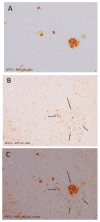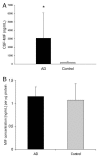The role of macrophage migration inhibitory factor in Alzheimer's disease
- PMID: 20200619
- PMCID: PMC2829616
- DOI: 10.2119/molmed.2009.00123
The role of macrophage migration inhibitory factor in Alzheimer's disease
Abstract
Previous studies have shown that amyloid beta protein (Abeta ), the essential molecule for the formation of toxic oligomers and, subsequently, Alzheimer plaques, has been associated in vivo with the immune modulator, macrophage migration inhibitory factor (MIF) (17). To further investigate this association in vivo we used the APP transgenic mouse model. Serial brain sections of transgenic APP mice were stained for Abeta plaques and MIF and we observed MIF immunolabeling in microglial cells in association with Abeta plaques in the transgenic mouse brain sections. In addition, functional studies in murine and human neuronal cell lines revealed that Abeta-induced toxicity could be reversed significantly by a small molecule inhibitor of MIF (ISO-1). Finally, to elucidate the role of MIF in Alzheimer's Disease (AD) we measured MIF levels in the brain cytosol and cerebrospinal fluid (CSF) of AD patients and age-matched controls. Our results demonstrate a marked increase of MIF levels within the CSF of AD patients compared with controls. Combined, our results indicate a strong role for MIF in the pathogenesis of AD and furthermore suggest that inhibition of MIF may provide a valuable avenue of investigation for the prevention of disease onset, progression and/or severity.
Figures




Similar articles
-
Upregulation of MIF as a defense mechanism and a biomarker of Alzheimer's disease.Alzheimers Res Ther. 2019 Jun 7;11(1):54. doi: 10.1186/s13195-019-0508-x. Alzheimers Res Ther. 2019. PMID: 31174614 Free PMC article.
-
Protective effect of ISO‑1 against advanced glycation end product aggravation of PC12 cell injury induced by Aβ1‑40.Mol Med Rep. 2019 Sep;20(3):2135-2142. doi: 10.3892/mmr.2019.10483. Epub 2019 Jul 9. Mol Med Rep. 2019. PMID: 31322215 Free PMC article.
-
Key role of MIF-related neuroinflammation in neurodegeneration and cognitive impairment in Alzheimer's disease.Mol Med. 2020 Apr 17;26(1):34. doi: 10.1186/s10020-020-00163-5. Mol Med. 2020. PMID: 32303185 Free PMC article.
-
Alzheimer's disease.Subcell Biochem. 2012;65:329-52. doi: 10.1007/978-94-007-5416-4_14. Subcell Biochem. 2012. PMID: 23225010 Review.
-
Emerging Role of the Macrophage Migration Inhibitory Factor Family of Cytokines in Neuroblastoma. Pathogenic Effectors and Novel Therapeutic Targets?Molecules. 2020 Mar 6;25(5):1194. doi: 10.3390/molecules25051194. Molecules. 2020. PMID: 32155795 Free PMC article. Review.
Cited by
-
Mucopolysaccharide diseases: a complex interplay between neuroinflammation, microglial activation and adaptive immunity.J Inherit Metab Dis. 2014 Jan;37(1):1-12. doi: 10.1007/s10545-013-9613-3. Epub 2013 May 8. J Inherit Metab Dis. 2014. PMID: 23653226 Review.
-
Macrophage migration inhibitory factor (MIF) in CNS diseases: Functional regulation and potential therapeutic indication.Fundam Res. 2023 May 30;4(6):1375-1388. doi: 10.1016/j.fmre.2023.05.008. eCollection 2024 Nov. Fundam Res. 2023. PMID: 39734533 Free PMC article. Review.
-
Expression of macrophage migration inhibitory factor in the mouse neocortex and posterior piriform cortices during postnatal development.Cell Mol Neurobiol. 2014 Nov;34(8):1183-97. doi: 10.1007/s10571-014-0094-1. Epub 2014 Aug 14. Cell Mol Neurobiol. 2014. PMID: 25118614 Free PMC article.
-
The relevance of serum macrophage migratory inhibitory factor and cognitive dysfunction in patients with cerebral small vascular disease.Front Aging Neurosci. 2023 Feb 7;15:1083818. doi: 10.3389/fnagi.2023.1083818. eCollection 2023. Front Aging Neurosci. 2023. PMID: 36824264 Free PMC article. Review.
-
Macrophage migration inhibitory factor promotes proliferation and neuronal differentiation of neural stem/precursor cells through Wnt/β-catenin signal pathway.Int J Biol Sci. 2013 Nov 28;9(10):1108-20. doi: 10.7150/ijbs.7232. eCollection 2013. Int J Biol Sci. 2013. PMID: 24339732 Free PMC article.
References
-
- McGeer PL, McGeer EG. Local neuroinflammation and the progression of Alzheimer’s disease. J Neurovirol. 2002;8:529–38. - PubMed
-
- Rosenberg ES, Simons J, Gualini F. Clinical aspects and treatment of posterior bite collapse due to accelerated wear. Int J Periodontics Restorative Dent. 1987;7:66–82. - PubMed
-
- Mrak RE, Griffin WS. Glia and their cytokines in progression of neurodegeneration. Neurobiol Aging. 2005;26:349–54. - PubMed
-
- Chao CC, Hu S, Ehrlich L, Peterson PK. Interleukin-1 and tumor necrosis factor-alpha synergistically mediate neurotoxicity: involvement of nitric oxide and of N-methyl-D-aspartate receptors. Brain Behav Immun. 1995;9:355–65. - PubMed
MeSH terms
Substances
LinkOut - more resources
Full Text Sources
Other Literature Sources
Medical
Miscellaneous

